Growing chives is fun and very easy because they require minimal care. In this post, I’ll show you everything you need to know in order to have the best success.
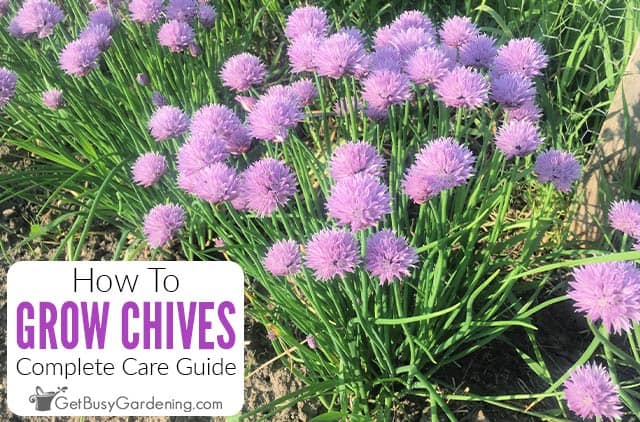
Having delicious chives growing year after year is much easier than beginner gardeners may think.
They don’t require much attention to thrive, and add many benefits to your garden.
This guide will teach you everything you need to know about how to grow chives. Get essential plant care advice on things like sun, water, soil, fertilizer, pruning, and so much more.
Chive Plant Care Overview
| Scientific name: | Allium schoenoprasum |
| Classification: | Herb |
| Common names: | Chives |
| Hardiness: | Zones 3-9 |
| Temperature: | 60-70°F |
| Flowers: | Purple or white, blooms in late spring or early summer |
| Light: | Full sun to partial shade |
| Water: | Allow soil to dry between waterings, do not overwater |
| Humidity: | Average |
| Fertilizer: | General purpose plant food in spring and summer |
| Soil: | Fast-draining, fertile soil |
| Common pests: | Onion flies, thrips |
Information About Chives
Chives (Allium schoenoprasum) are a member of the Alliaceae, or onion, family. They’re native to Europe and Asia, but now grow abundantly in many parts of the world, especially North America.
The hollow leaves have a very grass-like appearance, and feature a mild onion flavor that many gardeners appreciate in their cooking.
They typically grow no more than 2’ tall, and feature lavender or white flowers, depending on the type.
Different Types Of Chives
There are two main types of chives you can grow – the common one, and garlic chives (Allium tuberosum).
Common ones have tubular leaves, purple blooms, and an onion flavor. The garlic variety is taller, less cold hardy, has flat, garlic-flavored leaves, and produces white flowers.
Both are beautiful, delicious, and require the same care and attention to grow.
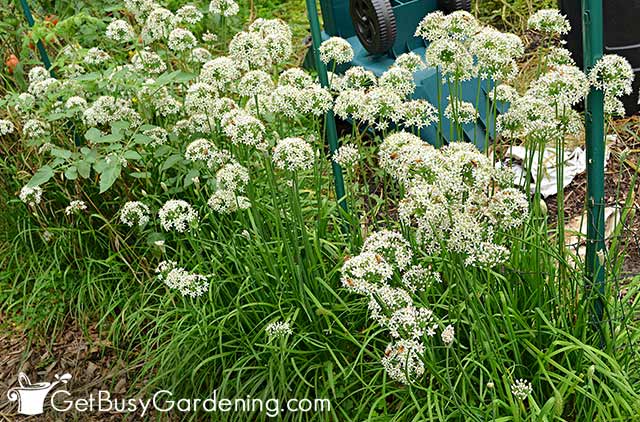
Hardiness
Chives are cold hardy perennials in zones 3-9. They’ll grow well in temperatures down to 40°F, and go dormant through winter when it drops below freezing.
They can also be overwintered indoors in containers, and moved back outdoors, or replanted, in the spring.
Flowers
One of the benefits of growing chives is the stunning flowers. They bloom in late spring to early summer, and appear as pale purple clusters on the top of long stalks.
The flowers are not only attractive to pollinators, but they’re edible as well. They’re a great addition to salads, or can be used to infuse things like olive oil or butter.
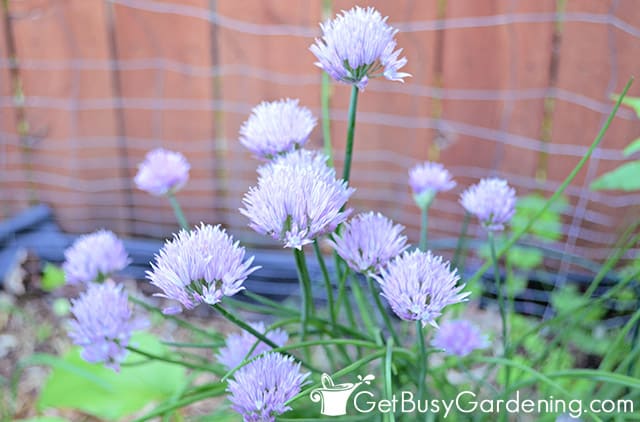
How Do Chives Grow?
Chives grow in dense clumps from small bulbs under the soil. They send up fragrant tube-like leaves that can be cut from spring through fall, or even year-round in warmer areas.
They are rampant re-seeders, and can easily spread through your garden if not carefully maintained. Learn how to save the seeds here.
How To Grow Chives
Before we get into chive plant care, let’s first discuss how to choose the ideal time and location to grow them. The right place and timing can make all the difference in their long-term health.
Where To Grow Chives
Chives can grow in varying levels of light, but prefer full sun. They can thrive in both the ground and containers, or even indoors.
They’re commonly used as path or garden edging plants to create a green perennial border, and act as pest repellent.
No matter where they’re placed, they need well-drained soil or a pot with holes in the bottom to prevent rot.
When To Plant Chives
You can plant your chives as soon as the soil is workable in late winter or early spring.
They grow well in temperatures as low as 40°F, but will flourish when the ground is between 60-70°F. Check it with a soil thermometer before planting.
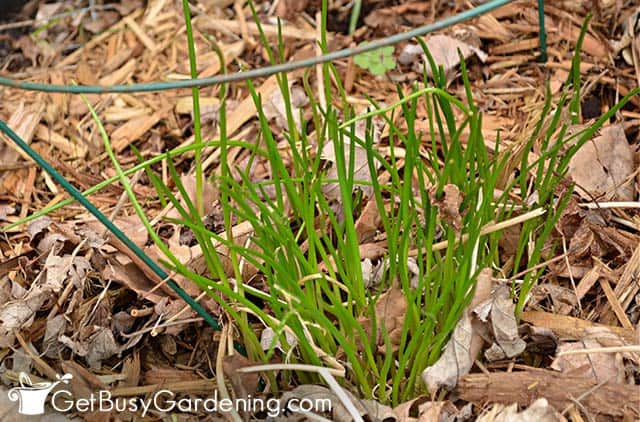
Chives Plant Care & Growing Instructions
Now that you know when and where to plant them, let’s talk about how to grow chives. Creating the ideal environment will make their care very low maintenance.
Sunlight
Chives prefer 6-8 hours of full sun per day, but also grow well in partial shade with as little as 4 hours.
Excessive heat and sunshine can cause scorching. So if you live in a very warm climate, providing shade during the afternoon hours is a good idea.

Water
Keep the roots moist and provide consistent water for the best chance at a continual, good crop.
Chives will grow best with deep watering, but won’t tolerate soggy feet for very long.
Give them a thorough drink whenever the soil has dried 1” down. You may need to check more often during heat waves to prevent them from drying out.
If you struggle to find the right balance, a moisture gauge can be a handy tool to help you get it just right.
Temperature
The ideal temperature range for chives is wide, but they grow best when it’s between 40-80°F.
They’re very cold hardy, and will survive many frosts and freezes, but go dormant when temperatures reach extreme lows.
Anything higher than 80°F will trigger flowering, and excessive heat can cause them to go dormant until it cools again in the fall.
Fertilizer
Chives don’t require a lot of fertilizer to grow well. In fact, excess amounts can cause such rapid growth that they lose flavor.
Side-dressing with compost or worm castings once a season is usually all they’ll need.
However, if yours have been growing in the same container for a few years, adding a diluted liquid fertilizer like compost tea or fish emulsion once a month can rejuvenate the nutrients.
Organic, high-nitrogen granular options are also a good choice, and can be worked into the soil once or twice a year.
Soil
Chives aren’t picky about the type of soil, but they may suffer an increased risk of root rot if grown in a heavy, poor-draining location.
Their ideal mix is well-draining and fertile, with a pH between 6.0-7.0 on a probe meter.
Prepping the bed, or side-dressing established plants yearly with compost or worm castings can provide plentiful nutrients, and improve drainage.

Pruning
Learning how to prune them is an important step in keeping your chives growing steady, but also to prevent the potential spread throughout your garden.
Deadhead spent flowers before they reseed, and cut back the leaves after they die back in the fall so they can have a fresh start in the spring.
Pest Control
Chives don’t usually have any issues with pests, their strong flavor and fragrance can actually work as a deterrent. But occasionally they can suffer from onion flies or thrips.
Keep bugs in control by targeting them with an insecticidal soap. I make my own using 1 teaspoon of mild liquid soap mixed with 1 liter of water.
Disease Control
The most common diseases that affect chives are leaf and bulb rot, or mildew. Both of these are often caused by poor drainage, overcrowding, or improper watering practices.
Amend heavy soils with compost to help improve drainage. Always water near the base of the plant to prevent moisture from sitting on the leaves, or splashing soil.
For crowded plants, pruning or dividing them can increase airflow and overall health.
Tips For Harvesting Chives
Harvesting is easy. Chive leaves are best taken in the morning, and the new, tender ones have the strongest flavor and most tender texture. Cut them at the base, 1-2” above the soil.
To enjoy the flowers, pick them when they’re newly opened and bright purple. They will lose their flavor and become woody as they fade.
Related Post: How To Freeze Herbs Fresh From The Garden
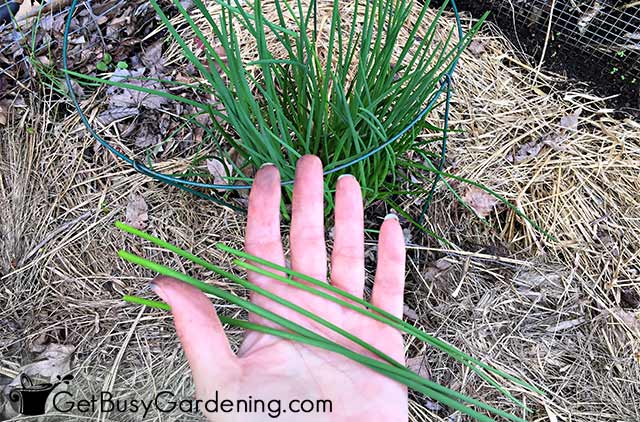
Chive Propagation Tips
Chives are simple to propagate from seed. In fact, they will sow themselves all over your garden if left unattended.
Division is also fairly easy, and a great way to rejuvenate a mature plant. Always take clumps, rather than individual bulbs, and tackle it in the early spring to give them plenty of time to reestablish.
Troubleshooting Common Problems
Chives are very easy to grow once established, but you may run into one of these common issues throughout their life. Use these tips to help get them back into a healthy condition.
Chives Turning Yellow
The main reasons why chives turn yellow are lack of space, transplant shock, overwatering, or age.
Crowded plants will start yellowing at the tips, then move down the entire leaf. Divide or trim them to create more space. Older plants need pruning to rejuvenate them.
If yours are yellowing and wilting they may be too wet, so let them dry out more between drinks.
Leaves Turning Brown
Brown leaves can be caused by excessive sun and heat, overwatering, disease, or the cold.
Provide afternoon shade during hot spells to prevent scorching, and wait until the top inch of soil has dried to give them a drink.
If brown spots appear, they may be suffering from blight. Spray with an organic fungicide to help get rid of it, or trim away affected leaves quickly and dispose of them.
Browning also happens when temperatures get too low and the plant starts to go dormant. This is normal, and they will grow again once it starts to warm up in late winter or early spring.
Plant Falling Over
The most common causes of chives falling over are temperature swings, lack of sunlight, or overcrowding.
When temperatures are too high or too low, they may fall over temporarily. Give large plants a good trim to help improve airflow, and revitalize the growth.
If your plant gets less than 4 hours of sunlight per day, it may simply need a sunnier location to thrive.
Chives Not Growing
If your chives are not growing they may be dormant, need more sunlight, or they have been improperly watered.
Stick with even and consistent moisture, and provide them with 4 or more hours of direct sun per day.
If temperatures are above or below the 40-80°F range, they may go dormant, which causes slow or stalled growth.
Plant Wilting / Drooping
Wilting or drooping is often a symptom of heat stress, improper watering, or pests.
During a heat wave, try providing afternoon shade to protect them, and keep an eye on how quickly they’re drying out.
Check for signs of bugs too, and start treating them immediately if you find any.
FAQs About Growing Chives
Here I’ve answered some of the most commonly asked questions about growing chives. If yours isn’t on the list, please add it to the comments section below.
How long does it take chives to grow?
It doesn’t take chives very long to grow, they are fairly fast. They take about 60 days to mature from seed to harvest, or 30 days from starts or transplants.
Are chives easy to grow?
Chives are easy to grow once you understand how to create their ideal environment. Provide ample sun, consistent water, and regular pruning to keep them healthy.
Do chives like sun or shade?
Chives like full sun, but can also grow well in partial shade. If you live in a place where temperatures regularly exceed 80°F, provide partial shade in the afternoon.
Do chives multiply?
Yes, chives can multiply fairly aggressively by reseeding themselves. To prevent this, deadhead the flowers as soon as they begin to fade.
Are chives annual or perennial?
Chives are perennials in zones 3-9. They will go dormant during freezing temperatures, but will grow back when it warms again in the spring.
Should you let chives flower?
You can let chives flower if you’d like, it doesn’t change their flavor. The flowers are beautiful, attractive to pollinators, and edible. You can cut them back once they fade to prevent reseeding, if desired.
With all the chive plant care tips shared in this guide, even beginners can grow them in their gardens successfully. You’ll be able to keep them thriving and enjoy them year after year.
If you want to learn all about how to grow any of your crops up rather than out, then you need my Vertical Vegetables book. It will show you all you need to know in order to have both beautiful and highly productive gardens. Order your copy today!
Learn more about my Vertical Vegetables book here.
More About Herb Gardening
- How To Grow Dill At Home
- How To Grow Oregano Plant At Home
- How To Grow Thyme At Home
- How To Grow Parsley At Home
- How To Grow Tarragon At Home
Share your tips for growing chives in the comments section below.
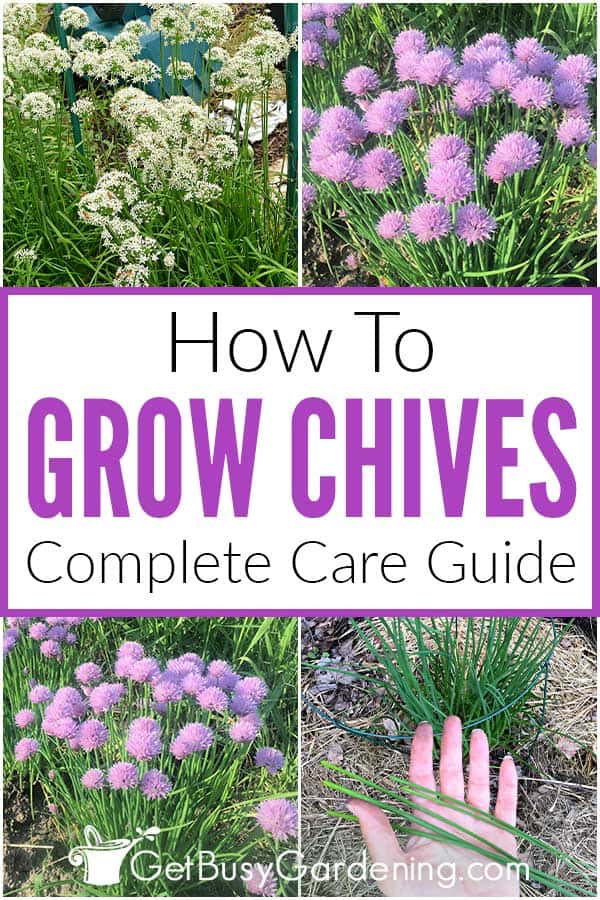
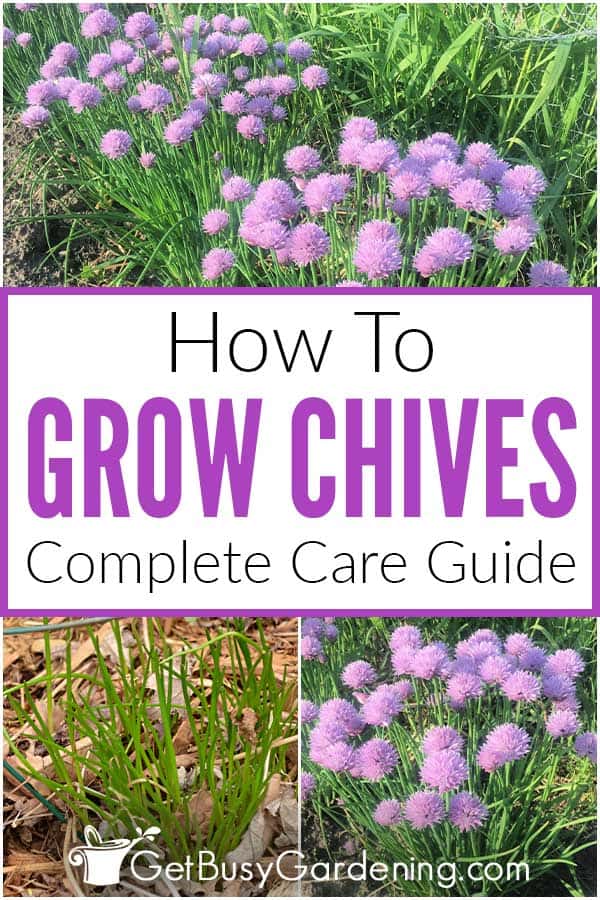
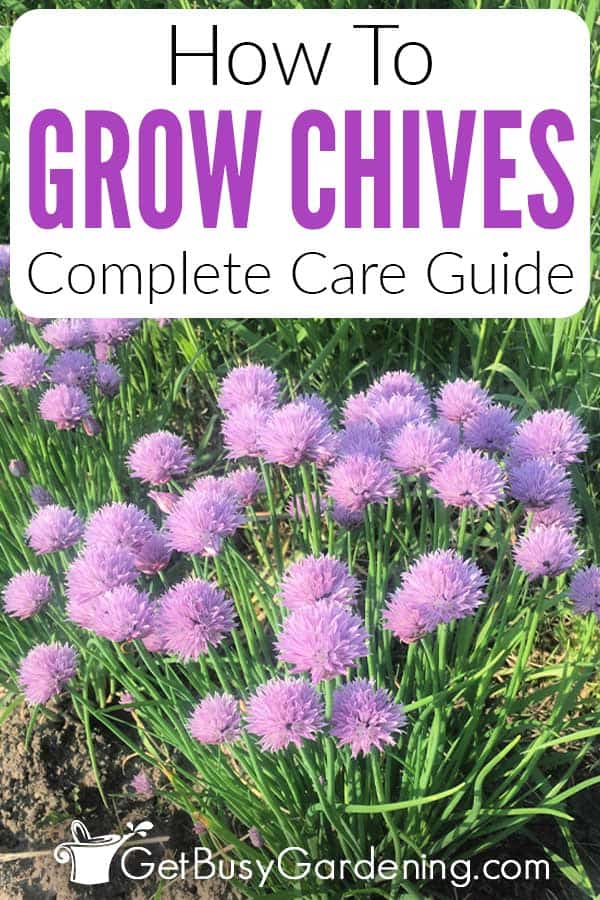



Dietrich Schroeder says
How deep does the soil need to be when growing chives in a container?
Amy Andrychowicz says
It depends on the size of your plant. I have successfully grown chives in a 6″ container, and they’ve done very well. Then, once they outgrow the pot, you can repot them into a larger one, they’re not bothered by being repotted/transplanted at all. The larger the plant, the larger the pot you should use.